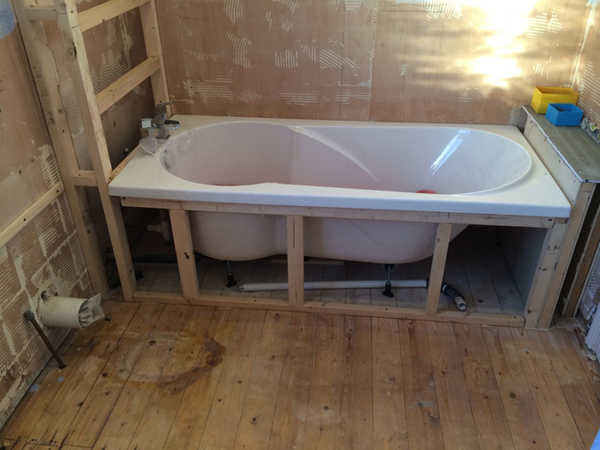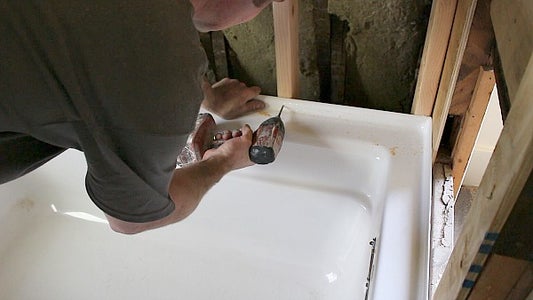The Basics of Plumbing Skills When Installing a Bathtub
The Basics of Plumbing Skills When Installing a Bathtub
Blog Article
We've come across this great article on Installing A Bathtub below on the net and reckoned it made perfect sense to talk about it with you here.

Mounting a bath tub isn't specifically rocket science, but it does require solid plumbing, carpentry, and in some cases, tiling skills. Replacing an old bathtub with a brand-new one is likewise a moderately difficult project. If the old bathtub is conveniently obtainable, the task can move rapidly; if you have to open a wall to get rid of the old bathtub as well as position the brand-new tub, the task is a lot harder. In either case, the task is within a residence handyman's skills, although you will need a helper to vacate the old bathtub as well as set in the brand-new one. See to it you have certified yourself for the job and also are comfortable attempting it. As opposed to employing a professional to take control of a halfway-completed job, it is much better to consider using one before you start. Chances are you might need an expert plumber to make tube connections.
This post will assist you install a brand-new bathtub in your shower room if you have actually already gotten a brand-new tub as well as do not need to alter the arrangement of your previous water pipes.
Your tools as well as product checklist ought to comprise the following:
Removing Old Taps
If you require to replace old faucets with brand-new ones as a part of your setup, after that the first thing you need to do is separate the supply of water. After doing so, switch on the taps to drain any type of water staying in the system. The process of eliminating the existing taps can be quite problematic due to the limited gain access to that is usually the case.
Make use of a container wrench (crowsfoot spanner) or a tap device to reverse the nut that links the supply pipelines to the faucets. Have a cloth all set for the continuing to be water that will come from the pipelines. When the supply pipes have actually been removed, make use of the exact same device to loosen the nut that holds the faucets onto the bath/basin. You will require to quit the single taps from transforming during this procedure. Once the faucets have actually been eliminated, the holes in the bath/basin will certainly need to be cleansed of any kind of old sealing substance.
Prior to carrying on to fit the brand-new taps, compare the pipeline links on the old taps to the brand-new faucets. If the old taps are longer than the new faucets, after that a shank adapter is needed for the new taps to fit.
Fitting New Touches
If the tails of the brand-new taps are plastic, after that you will require a plastic adapter to stop damage to the thread. One end of the port fits on the plastic tail of the faucet and also the various other end provides a connection to the existent supply pipes.
If you need to fit a monobloc, then you will require reducing couplers, which connects the 10mm pipe of the monobloc to the basic 15mm supply pipe.
Next off, place the tap in the placing opening in the bath/basin making certain that the washing machines are in place between the faucet as well as the sink. Protect the tap in position with the producer offered backnut. Once the faucet is safely in place, the supply pipelines can be linked to the tails of the taps. The faucets can either be linked by using corrugated copper piping or with normal faucet connectors. The previous type needs to be connected to the faucet ends initially, tightening only by hand. The supply pipelines can later on be linked to the various other end. Tighten up both ends with a spanner after both ends have actually been linked.
Mounting the Tub
Making use of the two wood boards under its feet, put the bath tub in the required setting. The wood boards are valuable in equally spreading the weight of the bathtub over the area of the boards as opposed to concentrating all the weight onto four tiny factors.
The following goal is to guarantee that the tub is leveled all round. This can be achieved by inspecting the spirit level as well as readjusting the feet on the bath tub till the spirit level reads level.
To mount taps, fit the bottom of the outermost flexible tap port to the proper supply pipeline by making a compression sign up with; after that do the exact same for the various other faucet.
Activate the water supply and also examine all joints and also brand-new pipework for leakages as well as tighten them if required. Fill the bathtub as well as also examine the overflow electrical outlet as well as the normal electrical outlet for leakages.
Lastly, repair the bathroom paneling as explained in the producer's user's manual. Tiling and sealing around the bath tub ought to wait until the tub has been utilized at least when as this will resolve it into its last position.
Getting ready for the Installation
First of all, the supporting structure supplied with the bath needs to be fitted (if required) according to the supplier's instructions. Next, fit the faucets or mixer to the bathtub. When fitting the tap block, it is necessary to see to it that if the tap comes with a plastic washer, it is fitted between the bathroom and also the faucets. On a plastic bathroom, it is likewise practical to fit a sustaining plate under the faucets device to stop pressure on the bath tub.
Fit the flexible tap connectors to the bottom of the two faucets utilizing 2 nuts as well as olives (in some cases supplied with the tub). Fit the plug-hole outlet by smearing mastic filler round the sink electrical outlet hole, and then pass the electrical outlet via the hole in the bathroom. Utilize the nut supplied by the maker to fit the plug-hole. Examine the plug-hole outlet for an inlet on the side for the overflow pipeline.
Next off, fit the end of the adaptable overflow pipe to the overflow electrical outlet. Afterwards, screw the pipe to the overflow face which should be fitted inside the bathroom. Make certain you use every one of the provided washers.
Attach the trap to the bottom of the waste electrical outlet on the bathtub by winding the string of the waste outlet with silicone mastic or PTFE tape, and also screw on the catch to the outlet. Attach the bottom of the overflow tube in a comparable manner.The bath must currently prepare to be suited its last setting.
Tiling Around the Bath tub
In the location where the bathroom meets the ceramic tile, it is essential to seal the joins with a silicone rubber caulking. This is essential as the installation can relocate enough to fracture a rigid seal, triggering the water to permeate the wall surface in between the bathroom and the tiling, resulting in issues with wetness and also feasible leakages to the ceiling below.
You can choose from a variety of coloured sealants to blend in your fixtures and fittings. They are offered in tubes and cartridges, and are capable of securing voids up to a size of 3mm (1/8 inch). If you have a bigger space to fill up, you can fill it with twists of soaked newspaper or soft rope. Remember to constantly fill up the tub with water prior to sealing, to permit the activity experienced when the tub is in usage. The sealant can crack rather early if you do not take into account this activity prior to sealing.
Conversely, ceramic coving or quadrant floor tiles can be used to border the bath or shower tray. Plastic strips of coving, which are easy to use and also cut to dimension, are additionally easily offered on the marketplace. It is advisable to fit the ceramic tiles making use of waterproof or waterproof sticky and also grout.
Bathtub Installation
How Important Is A Bathtub To Your Home?
High-quality baths, showers, and other bathroom updates are necessary when considering a smart investment in your home. It’s a room that you go to every day and one that is constantly being used by guests.The bathroom is one of the top trafficked rooms in a home and also one of the most valuable in terms of home resale.
Install Piping Before Tub
You will be using your existing drain and waste vent system, but pipes required include the hot and cold water supply lines and a pipe leading to a shower head. A mixing valve and shower head are also needed. Air chambers may be required.
Position the Tub
Lower the tub into place so that the continuous flange fits against the wall studs and rests on 1’x4' or 2’x4' supports. Anchor the tub to the enclosure with nails or screws inserted through the flanges into the studs.
NOTE: Remember, bathtubs and shower stalls may require support framing. A bathtub filled with water is extremely heavy, so check building codes and framing support before installing the tub.
Assemble Drain Connections
Assemble the bathtub drain connections by connecting the tub overflow with the tub drain above the trap, not beyond it. The trap will have a compression fitting that screws over the arm of the overflow assembly.
Place a Pipe For the Shower Head
First, locate a brass female threaded winged fitting and attach it to a framing support via a screw or a nail. Then run a pipe up the wall for the shower head. Sweat or solder the other side of the brass fitting to the top of the pipe.
Attaching Hot and Cold Water Lines
Attach your water lines for both hot and cold by sweating these directly into the hot and cold ports of the mixing valve. The mixing valve will be how water enters the tub’s system, not by the pipes themselves.
Install the Spout
Extend a piece of 1/2 inch pipe, or whichever length is specified in the manufacturer’s instructions, for the tub spout. Sweat on a male threaded fitting at the end of the pipe or use a brass nipple of the proper length and a 1/2 inch cap.
NOTE: At this point you should have your rough-in plumbing work inspected before proceeding further.
Check For Leaks
Restore the water pressure and check the drain connection and the supply pipes for any sign of leaking.
estore the Bathroom Wall
Replace the wall with moisture-resistant drywall as a base for your wall covering. Seal the joints between the wall and your new tub with silicone caulk as protection against water seepage.
https://www.berkeys.com/2016/12/02/bathtub-installation-dallas/

As a fervent reader on How to Install a Bathtub Yourself, I thought sharing that editorial was a good thing. If you enjoyed reading our blog posting if you please remember to share it. Kudos for your time. Kindly stop by our blog back soon.
Secure your plumbing; seek professionals. Report this page